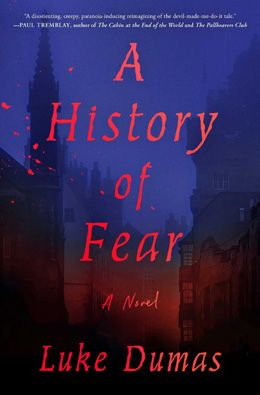Nothing beats a creepy-as-hell read as the chill of Winter settles in. “The Devil is in Scotland” is poised to become one of those iconic opening lines of literature—one that is uttered in reverence, often imitated, but rarely replicated. With that simple statement, Luke Dumas’ A History of Fear is off and running and it will not let loose its grip on the reader until the final page is turned. Only then can the truth be revealed to those—both characters and readers—who have survived long enough to reach the conclusion.
When Grayson Hale is found dead in his prison cell, a handwritten manuscript is also found on the premises. This manuscript purports to contain the truth regarding the gruesome death of Hale’s classmate, Liam Stewart, the crime for which Grayson Hale had been convicted. In it, Grayson documents the journey that led him to enroll at the University of Edinburgh and to a pivotal decision he made to accept a ghostwriting assignment offered by a strange gentleman—both choices that would greatly alter the course of his life.
While telling of his early life in San Diego and the path that led to his overseas schooling, readers learn that Grayson suffers from Satanophobia, a condition that causes him to believe the Devil is always after him. As Grayson’s manuscript is continuously interrupted with outside documents—court transcripts, newspaper clippings, police interviews, various correspondence, and more—readers begin to understand they are witnessing one man’s descent into madness, but the question remains regarding the Devil’s involvement.
In this case, the novel’s title does Yeoman’s work including clueing readers into an important fact about the book. Fear is a very personal and individual thing. Even in cases where we all might be afraid of the same thing, the source and reason for this fear can be very different. This novel is called A History of Fear, not The History of Fear. It is the story of the history of Grayson Hale’s fear, crafting a compelling portrait of one man, who may or may not be hallucinating, delusional, and subjected to a host of other mental breakdowns—all possibly caused by a combination of factors that would constitute too much of a spoiler for this review. By juxtaposing Grayson’s fears with those of religious zealots; Grayson’s acquaintances, colleagues, and companions; and the nation of Scotland’s fear itself, Luke Dumas generates a final result that will linger in the minds of the reader for years to come.
Luke Dumas’s writing style is very dense, but somehow easy to read. In a feat that almost seems magical, Dumas manages to craft sentences that feel both classical and contemporary simultaneously—treading a line that is not often seen in modern horror novels. A History of Fear would fit very nicely on a shelf between Bram Stoker’s Dracula and Thomas Harris’ The Silence of the Lambs. There is no doubt that this novel should be classified as a horror novel, but there are plenty of mysteries to be solved through the complex story to please even the most jaded crime fiction reader. The final chapter of A History of Fear leaves the reader with questions to ponder, not about the plot of the novel per say, but about the state of the world and our understanding of fear, evil, and the Devil himself.
Open A History of Fear at your own risk, because it will consume you and your time until you have turned the final page—and even then, the world Luke Dumas exposes will take up residence in your mind, rent free, though perhaps not consequence free.

BUY LINKS: A History of Fear by Luke Dumas
Disclaimer: A print galley of this title was provided to BOLO Books by the author. No promotion was promised and the above is an unbiased review of the novel.
